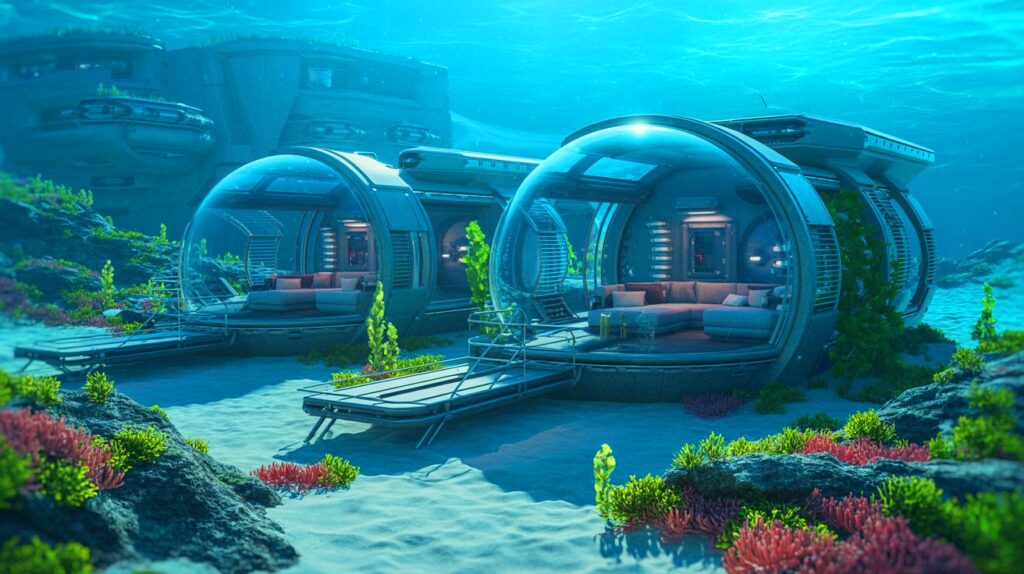| In Brief |
|
For millions of years, evolution has pushed humans to leave the oceans to live on land. However, recent technological advancements are prompting a re-evaluation of our relationship with water. Today, ambitious projects are emerging to make permanent underwater habitation a reality. The British company Deep intends to construct underwater residences by 2027, potentially signaling a return to our aquatic roots. These initiatives not only aim to exploit the untapped resources of the oceans but also to create new opportunities for innovation. With futuristic habitats like “Vanguard,” Deep hopes to transform our perception of underwater life.
Deep’s Ambition: A New Era of Underwater Exploration
Deep aims to revolutionize ocean exploration with innovative underwater habitats. The goal is to develop structures capable of withstanding the pressure of ocean depths. The first habitat, “Vanguard,” is designed for short-term missions and can accommodate three professional divers. Covering an area of 28 square meters, it will be installed about 100 meters below the surface, in the ocean’s illuminated zone. This project serves as a precursor to the “Sentinels” units, which will offer 28-day stays for six people at depths of up to 200 meters. These habitats will be equipped with bedrooms, a kitchen, and a scientific laboratory, providing all the necessary comforts for extended missions.
Inspired by past projects like Sealab, Deep hopes to push the boundaries of our understanding of the oceans. While these initiatives are ambitious, they rely on proven technologies, such as arc wire additive manufacturing, which enables the creation of structures capable of supporting underwater pressure. With these innovations, Deep aims to make the ocean accessible to all.
The Technical Challenges of Underwater Living
Living underwater presents considerable technical challenges. Life at great depths requires adaptation to extreme conditions of pressure and air composition. Studies have shown that the human body, saturated with inert gases, can theoretically withstand continuous pressure. However, surfacing can lead to decompression accidents with serious consequences. Furthermore, since the air inhaled underwater is denser, understanding the long-term effects on human health is crucial.
Another hurdle is the physiological need for sunlight. During a recent experiment, Joseph Dituri, nicknamed “Dr. Deep Sea,” spent 100 days underwater under careful health monitoring. While there were benefits like improved REM sleep, his stay highlighted the essential need for natural light for human well-being. These challenges require innovative solutions to consider long-term underwater colonization.
Ecological Impact of Underwater Habitats
The establishment of underwater habitats raises environmental questions. Preserving marine ecosystems is crucial in the face of climate change. Introducing metal structures into these fragile environments could disrupt already vulnerable habitats. The oceans harbor immense biodiversity, much of which is still unknown. It is essential to reconcile exploration with respect for the environment.
Deep is committed to conducting thorough studies to minimize the impact of its installations. The goal is to integrate the habitats into the marine ecosystem, respecting local flora and fauna. A better understanding of the oceans will enable the development of effective conservation strategies, ensuring a balance between innovation and preservation.
A Promising Future for Underwater Habitats


Despite the challenges, Deep remains optimistic about the future of underwater habitats. The company plans to extend its projects worldwide, aiming for a birth under the sea by 2050. This would symbolize a return to the aquatic origins of humanity. By collaborating with international partners, Deep hopes to raise awareness about the importance of marine conservation.
Deep’s vision goes beyond exploration. It aims to inspire a new generation of innovators and researchers ready to push the boundaries of knowledge. Ultimately, these initiatives could transform our relationship with the oceans. What will be the extent of our commitment to preserve these vast aquatic expanses while exploring their infinite possibilities?









